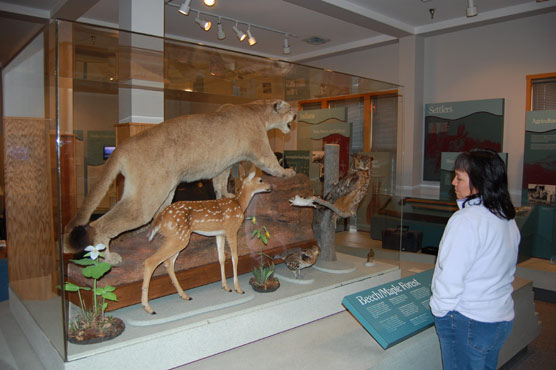|
You are viewing ARCHIVED content published online before January 20, 2025.
Please note that this content is NOT UPDATED, and links may not work. For current information,
visit https://www.nps.gov/aboutus/news/index.htm.

NPS
Contact: Steve Yancho, 231-326-5134 Do you really think you saw a cougar? Now you can compare what you saw to a real one. The National Park Service (NPS) has added a cougar mount to the exhibits at Sleeping Bear Dunes National Lakeshore’s Visitor Center in Empire. The public is invited to stop in and view this majestic animal, often reported within the Lakeshore and surrounding area. The mount is on temporary loan from Michigan State University Museum in East Lansing, MI. The cougar once claimed much of North America as part of its home range, but is now thought to have been extirpated from the Lower Peninsula of Michigan. The last reported wild cougar was taken in the Upper Peninsula near Newberry in 1906. Despite this, there have been numerous reports of cougar sightings throughout the Lower Peninsula and the Lakeshore during the past several years. National Park Service biologists, however, have been unable to verify even one report with physical evidence. “We are pleased to not only be able to display one of Michigan’s historic predators, but perhaps also to provide an educational tool so that visitors have a basis upon which to evaluate these reported observations,” said Dusty Shultz, Lakeshore Superintendent. “We are grateful to Michigan State for loaning us the mount through the end of this year.” From November 2004 through April 2005, researchers conducted studies on more than 150 miles of roads and trails that crossed through all major habitat types in the Lakeshore, utilizing three methods to attempt to document cougar presence: remote motion-sensing camera systems; track surveys; and investigations of reported observations of cougars or their sign. These methods have been used in numerous studies elsewhere to assess cougar presence. The motion-sensing cameras were operational for 863 nights and not a single image of a cougar was obtained. However, many other animals were documented, including bobcat, coyote, red fox, domestic dog, house cat, raccoon, deer, several bird species, red squirrel, and humans. Snow track surveys were conducted on over 304 miles of roads and trails, and nearly 460 carnivore tracks were identified including 22 bobcat, 300 coyote, and 40 red fox, as well as striped skunk, river otter, mink, and weasel. During the course of the study, five reported sightings of cougars or their tracks were investigated, all within 24 hours. No cougar sign was found at any of these reported sighting areas, but tracks were identified by biologists as bobcat, coyote, or domestic dog. Although the six months of intensive study did not yield any physical evidence to support the reported presence of cougars in the park, sightings continue to persist. National Lakeshore biologists maintain a database of reported cougar sightings and investigate them as quickly as possible. The Sleeping Bear Dunes National Lakeshore Visitor Center is located on highway M-72 in Empire. It is open from 8:15 a.m. until 4:00 p.m. through Memorial Day and until 6:00 p.m. after the holiday. Sleeping Bear Dunes National Lakeshore is one of over 390 sites saved by the American people and administered by the National Park Service so that all may experience our heritage. For more information about the park, please go to www.nps.gov/slbe. |
Last updated: April 10, 2015
